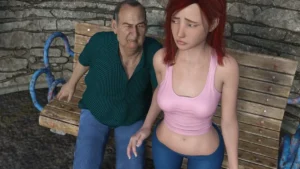
The Theater of Sinners
Play The Theater of Sinners
The Theater of Sinners review
Explore the dark narrative, gameplay mechanics, and character development in this adult visual novel
The Theater of Sinners stands as a decision-based adult visual novel that immerses players in a complex narrative exploring themes of corruption, humiliation, and moral ambiguity. Developed by JustXThings using the Ren’Py engine, this psychological fantasy horror experience features interleaved stories of multiple protagonists navigating dark circumstances. The game combines compelling character development with interactive storytelling, allowing players to shape character destinies through meaningful choices. Whether you’re interested in the narrative depth, character arcs, or gameplay mechanics, understanding what makes this title unique requires exploring its intricate design and thematic elements.
Understanding The Theater of Sinners: Story, Setting & Characters
Let me tell you about the first time I realized The Theater of Sinners wasn’t going to be a typical visual novel. I made a seemingly minor choice—to have Paula, a character from a privileged background, silently endure a public insult rather than retaliate. I thought I was being mature, taking the high road. The game, however, recorded this as a point toward “Submission.” This single decision subtly altered her dialogue options later, locking me out of a more defiant path and leading her deeper into a situation she couldn’t control. 😱 That was my “aha!” moment. This Ren’Py visual novel is a masterclass in decision-based gameplay, where every choice, no matter how small, has weight, permanently etching itself onto your characters’ souls and the Theater of Sinners story.
This isn’t a game about saving the world from a cartoonish villain. It’s about navigating a world where the villain is often the person staring back at you in the mirror, or the one sleeping next to you. It’s an adult psychological horror that finds its terror not in jump scares, but in the slow, chilling erosion of a person’s spirit. If you’re ready to explore a narrative that refuses to offer easy answers, you’ve come to the right place. Let’s pull back the curtain. 🎭
The Core Narrative: Themes of Corruption and Moral Complexity
At its heart, the Theater of Sinners story is a deep, uncomfortable dive into the mechanics of human degradation. The core premise is simple yet devastating: we follow the lives of several young women as they become entangled in a web of manipulation, brutality, and what the game provocatively frames as “love.” The central theme is corruption—not the kind with bribes and politicians, but the intimate, personal corruption of one’s values, desires, and very sense of self.
The game’s visual novel narrative is unflinching in its portrayal of humiliation. Characters are systematically broken down, not for a grand cosmic purpose, but for the petty, personal gratification of others. You’ll witness scenarios designed to strip away dignity, and you’ll be the one making the choices that either accelerate or resist this process. This creates a constant, gnawing tension. The “moral complexity” here isn’t a philosophical debate; it’s a lived experience. Is it better to submit and survive, or to resist and risk complete destruction? Is a twisted form of protection from an abuser preferable to having no protector at all? The game offers no clear good or evil paths, only varying shades of compromise and ruin. 😥
This is achieved through a brilliantly non-linear structure. The story is told through interleaved narratives and frequent flashbacks. You might be navigating a tense present-day scenario with Rebecca, only for the game to cut to a pivotal childhood memory with Paula that recontextualizes everything. This structure mimics the way trauma operates in real life—it’s not a linear story but a series of intrusive flashes that inform the present. The narrative is divided into “seasons,” much like a prestige TV drama, allowing for deep dives into specific character arcs and the long-term consequences of your cumulative choices in this branching storyline game.
Meet the Protagonists: Paula, Rebecca, and Beyond
The true strength of this character development game lies in its protagonists. They are not blank slates for you to project onto; they are fully realized, deeply flawed individuals with painful pasts and uncertain futures. Your role is not to “fix” them, but to guide them through their respective nightmares, with your decisions directly shaping their core personality traits.
🧩 Paula’s Struggle: Paula is the daughter of a powerful, influential figure. On the surface, she has everything—wealth, status, and a predetermined future. But this privilege is a gilded cage. Her story begins when she becomes entangled with a group of delinquents, a rebellion against the sterile, controlled life laid out for her. This is where your choices are critical. Will she maintain a shred of her privileged aloofness, or will she be completely consumed by the brutal world she’s stepped into? Her path is a tragic exploration of how the pursuit of “freedom” can lead to a far more insidious form of captivity.
🔥 Rebecca’s Torment: If Paula’s story is about falling from grace, Rebecca’s is about struggling to find any grace at all. Raised by a neglectful, addicted mother and a violently abusive stepfather, her entire life has been a fight for survival. She is hardened, distrustful, and fiercely independent, but also desperately vulnerable. Your decisions with Rebecca often revolve around trust. Will she learn to lower her defenses for a chance at genuine connection, or will she embrace her harsh upbringing as the only tool she has to navigate a cruel world? Her path is raw, visceral, and often the most difficult to witness.
They are not alone in this theater. The game features four main protagonists, each with their own cross to bear, and your decisions will chart their unique courses through despair and, however improbably, toward something resembling growth.
| Character | Background | Core Struggle |
|---|---|---|
| Paula | Daughter of a powerful political figure; lives a life of gilded privilege. | Rebellion vs. Conformity. Seeking authentic freedom while navigating the brutal consequences of her choices. |
| Rebecca | Raised in poverty by an addicted mother and abusive stepfather. | Survival vs. Connection. Learning to trust and be vulnerable in a world that has only ever hurt her. |
| Clarissa | A talented artist from a middle-class, but emotionally distant, family. | Ambition vs. Exploitation. Protecting her artistic integrity while being used as a tool for others’ agendas. |
| Maya | A former foster child who has learned to use charm and manipulation as survival tools. | Control vs. Chaos. Maintaining her carefully constructed persona as the world she navigates becomes increasingly volatile. |
Beyond our main players, the game populates its world with a diverse cast of side characters who are just as complex. You’ll meet people who are genuinely kind, others who are detestably cruel, and many who exist in the unsettling middle—characters who offer help with one hand while enabling destruction with the other. They are the supporting actors in this grand, tragic play, and your relationships with them are vital. ❤️🩹
World-Building: A Society Where Morals Are Grey
The world of The Theater of Sinners is not a dystopian future or a fantasy realm; it’s a grim reflection of our own society, just pushed to its logical, extreme conclusion. This is a world where power dynamics are everything, and morals are not just grey—they’re often entirely absent. The institutions that should protect people—family, school, the law—are either impotent, complicit, or actively predatory.
The game builds its atmosphere through meticulous detail. You’ll spend time in opulent, sterile mansions that feel more like prisons than homes. You’ll navigate run-down apartments where the smell of neglect is almost palpable. You’ll walk through school hallways that are battlegrounds for social status and cruelty. This environment is a key part of the adult psychological horror. The horror is in the mundane, the familiar places twisted into stages for humiliation and control. The game makes you feel the weight of these spaces, and how they shape and confine the characters trapped within them. 🌫️
This extends to the game’s approach to romance, which is one of its most challenging and unconventional aspects. Forget about sweet confessions and blushing dates. Relationships in this world develop through twisted, abusive dynamics. A character might form a “bond” with another out of fear, dependency, or a warped sense of gratitude for not being treated as badly as they could be. The game forces you to question what “love” really means in a context where manipulation and power are the primary currencies. Can affection born from coercion ever be real? Is protection offered by a captor a form of love, or just another layer of the cage? These are the uncomfortable questions the visual novel narrative demands you grapple with.
The brilliance of the decision-based gameplay is how it makes you complicit in this world-building. You aren’t just observing these grey morals; you are actively participating in them. Will you encourage Rebecca to seek protection from a powerful but manipulative figure, knowing the cost? Will you have Paula use her social standing to crush someone weaker, solidifying her own power? The branching paths don’t just lead to different endings; they lead to your characters becoming different people. The personality trait system (e.g., Submission/Defiance, Cynicism/Idealism) is the game’s way of quantifying the soul. Your choices in dialogue and action directly increase or decrease these traits, which in turn opens up or closes off entire story branches. It’s a profound character development game system that ensures no two playthroughs are the same, because no two versions of Paula or Rebecca are the same.
My practical advice for navigating this world? Embrace the discomfort. Don’t reload a save the second something bad happens. The most powerful moments in The Theater of Sinners come from sitting with the consequences of a decision you thought was innocent. Let your characters be flawed. Let them make terrible mistakes. Let them be corrupted or broken. It’s in these moments of “failure” that the game’s narrative shines brightest, offering a brutally honest look at the human condition under pressure. This Ren’Py visual novel is a challenging, thought-provoking experience that will stay with you long after you’ve put it down. 💔
“This story does not seek to judge its characters or its players. It seeks to explore the darkest corners of human relationships—the abuse, the humiliation, the unconventional bonds that form in the crucible of suffering. It’s a story about what people become when they are stripped of everything, and what they’ll cling to in order to feel something, anything at all.”
The Theater of Sinners represents a sophisticated approach to adult visual novel design, combining psychological depth with interactive storytelling. Through its decision-based mechanics, complex character development, and morally ambiguous narrative, the game offers players meaningful agency in shaping character destinies. The developer’s commitment to free distribution, combined with the game’s compelling artwork and well-written dialogue, has established it as a notable title within the visual novel community. Whether you’re drawn to the narrative complexity, character-driven storytelling, or the exploration of unconventional themes, The Theater of Sinners delivers an immersive experience that rewards player engagement and multiple playthroughs. For those interested in adult visual novels that prioritize story depth alongside mature content, this game merits exploration and consideration.





















